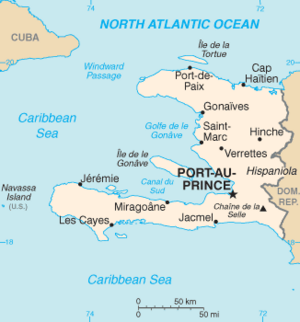Windward Passage
| Windward Passage | |
|---|---|
| Haiti and the Windward Passage - top left | |
| Connects waters | Caribbean Sea |
| with water | Atlantic Ocean |
| Separates land mass | Cuba |
| of land mass | Hispaniola |
| Data | |
| Geographical location | 20 ° 0 ′ N , 74 ° 0 ′ W |
| Smallest width | 80 km |
| Greatest depth | 1700 m |
The Windward Passage ( English for " windward passage") or the Paso de los Vientos ( Spanish for "Passage of the winds"; French Passage du Vent ) is a strait between the West Indies in the Caribbean , that between the islands of Cuba and Hispaniola lies. The 80 km wide strait is up to 1700 m deep and runs between the extreme south-east of Cuba and the north-west of Haiti . From the eastern headland of the Cuban province of Guantánamo , the lights can be seen on the other side of the Windward Passage in the Nord-Ouest department of Haiti (and vice versa) when the weather is favorable .
The strait creates a connection between the Atlantic and the Caribbean. It is the shortest shipping route between the Panama Canal, opened in 1914, and the east coast of the United States or the Sargasso Sea , which also gives it its strategic importance. Even before the opening of the Panama Canal, numerous goods and passengers were transported over the railway line built in 1848 on the Isthmus of Panama , which were then transported by ship through the Windward Passage. For example, 68% of all goods that are loaded or unloaded in US ports are transported through the Panama Canal and a large part of it is also transported onwards through the Windward Passage, as it is the main shipping route between the Panama Canal and the east coast of the USA. The American military base in the Bahía de Guantánamo, which has existed since the loan agreement of 1903, is also located on this strait, which is strategically so important for the USA. 50% of the maritime traffic between the Atlantic and the Caribbean occurs through the Windward Passage.
At the northeast exit of the strait is the Inagua archipelago belonging to the Bahamas with the islands of Great Inagua and Little Inagua . At the southwest exit of the strait lies the uninhabited island of Navassa, which belongs to the USA .
The trade winds that prevail from December to May blow from the northeast near the West Indies. The designation Windward (German: facing the wind; to windward ) thus refers to a sailing direction from west to east.
During the period of Spanish rule over Central and South America, the Spanish ships laden with gold returned to Spain through the Windward Passage or the Florida Strait . Here they were often ambushed by pirate ships, which were able to track down their prey better in the strait than in the vastness of the Caribbean or the Atlantic.
Today, the Windward Passage is also a route popular with drug smugglers who smuggle marijuana from Jamaica and cocaine from Colombia towards the United States. The US Coast Guard regularly patrols their boats and conducts patrol flights here. The US Coast Guard also intercepts illegal migrants from Haiti on their way to Florida here and leads them back to their home country.
The carbonate-rich North Atlantic deep water , the bottom current, flows from north to south, from the Atlantic to the Caribbean, through the strait. The surface water has the same direction of flow here.

